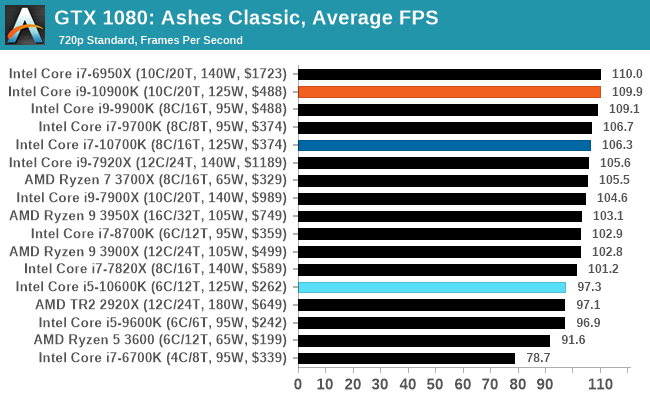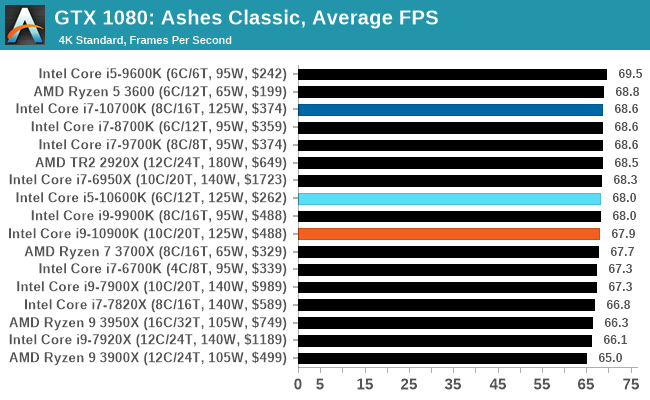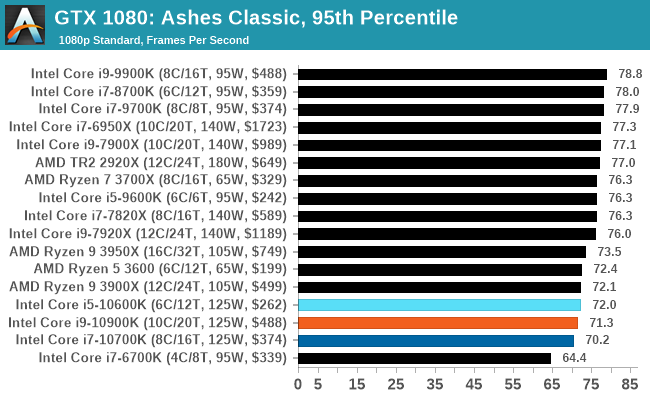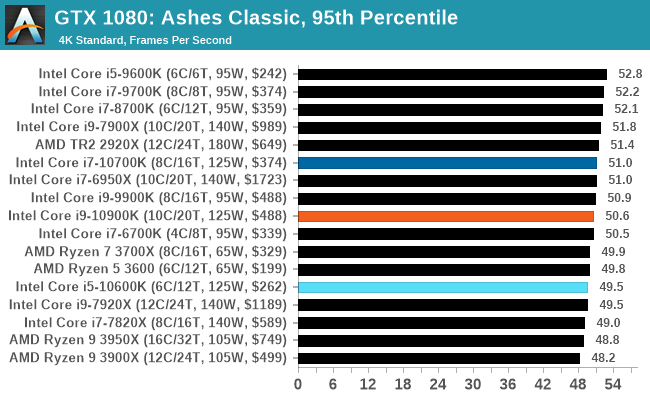The Intel Comet Lake Core i9-10900K, i7-10700K, i5-10600K CPU Review: Skylake We Go Again
by Dr. Ian Cutress on May 20, 2020 9:00 AM EST- Posted in
- CPUs
- Intel
- Skylake
- 14nm
- Z490
- 10th Gen Core
- Comet Lake
Gaming: Ashes Classic (DX12)
Seen as the holy child of DirectX12, Ashes of the Singularity (AoTS, or just Ashes) has been the first title to actively go explore as many of the DirectX12 features as it possibly can. Stardock, the developer behind the Nitrous engine which powers the game, has ensured that the real-time strategy title takes advantage of multiple cores and multiple graphics cards, in as many configurations as possible.
As a real-time strategy title, Ashes is all about responsiveness during both wide open shots but also concentrated battles. With DirectX12 at the helm, the ability to implement more draw calls per second allows the engine to work with substantial unit depth and effects that other RTS titles had to rely on combined draw calls to achieve, making some combined unit structures ultimately very rigid.
Stardock clearly understand the importance of an in-game benchmark, ensuring that such a tool was available and capable from day one, especially with all the additional DX12 features used and being able to characterize how they affected the title for the developer was important. The in-game benchmark performs a four minute fixed seed battle environment with a variety of shots, and outputs a vast amount of data to analyze.
For our benchmark, we run Ashes Classic: an older version of the game before the Escalation update. The reason for this is that this is easier to automate, without a splash screen, but still has a strong visual fidelity to test.
Ashes has dropdown options for MSAA, Light Quality, Object Quality, Shading Samples, Shadow Quality, Textures, and separate options for the terrain. There are several presents, from Very Low to Extreme: we run our benchmarks at the above settings, and take the frame-time output for our average and percentile numbers.
All of our benchmark results can also be found in our benchmark engine, Bench.

| AnandTech | IGP | Low | Medium | High |
| Average FPS |  |
 |
 |
 |
| 95th Percentile |  |
 |
 |
 |











220 Comments
View All Comments
ByteMag - Wednesday, May 20, 2020 - link
I'm wondering why the 3300X wasn't in the DigiCortex benchmark? This $120 dollar 4c/8t banger lays waste to the selected lineup. Or is it too much of a foreshadowing of how Zen 3 may perform? I guess benchmarks can sometimes be like a box of chocolates.ozzuneoj86 - Wednesday, May 20, 2020 - link
Just a request, but can you guys consider renaming the "IGP" quality level something different? The site has been doing it for a while and it kind of seems like they may not even know why at this point. Just change it to "Lowest" or something. Listing "IGP" as a test, when running a 2080 Ti on a CPU that doesn't have integrated graphics is extremely confusing to readers, to say the least.Also, I know the main reason for not changing testing methods is so that comparisons can be done (and charts can be made) without having to test all of the other hardware configs, but I have one small request for the next suite of tests (I'm sure they'll be revised soon). I'd request that testing levels for CPU benchmarks should be:
Low Settings at 720P
Max Settings at 1080P
Max Settings at 1440P
Max Settings at 4K
(Maybe a High Settings at 1080P thrown in for games where the CPU load is greatly affected by graphics settings)
Drop 8K testing unless we're dealing with flagship GPU releases. It just seems like 8K has very little bearing on what people are realistically going to need to know. A benchmark that shows a range from 6fps for the slowest to 9fps for the fastest is completely pointless, especially for CPU testing. In the future, replacing that with a more common or more requested resolution would surely be more useful to your readers.
Often times the visual settings in games do have a significant impact on CPU load, so tying the graphical settings to the resolution for each benchmark really muddies the waters. Why not just assume worst case scenario performance (max settings) for each resolution and go from there? Obviously anti-aliasing would need to be selected based on the game and resolution, with the focus being on higher frame rates (maybe no or low AA) for faster paced games and higher fidelity for slower paced games.
Just my 2 cents. I greatly appreciate the work you guys do and it's nice to see a tech site that is still doing written reviews rather than forcing people to spend half an hour watching a video. Yeah, I'm old school.
Spunjji - Tuesday, May 26, 2020 - link
Agreed 99% with this (especially that last part, all hial the written review) - but I'd personally say it makes more sense for the CPU reviews to be limited to 720p Low, 1080P High and 1440P Max.My theory behind that:
720p Low gives you that entirely academic CPU-limited comparison that some people still seem to love. I don't get it, but w/e.
1080p High is the kind of setting people with high-refresh-rate monitors are likely to run - having things look good, but not burning frames for near-invisible changes. CPU limiting is likely to be in play at higher frame rates. We can see whether a given CPU will get you all the way to your refresh-rate limit..
1440p Max *should* take you to GPU-limited territory. Any setting above this ought to be equally limited, so that should cover you for everything, and if a given CPU and/or game doesn't behave that way then it's a point of interest.
dickeywang - Wednesday, May 20, 2020 - link
With more and more cores being added to the CPU, it would've been nice to see some benchmarks under Linux.MDD1963 - Wednesday, May 20, 2020 - link
Darn near a full 2% gain in FPS in some games! Quite ...uhhh..... impressive! :/MDD1963 - Wednesday, May 20, 2020 - link
Doing these CPU gaming comparisons at 720P is just as silly as when HardOCP used to include 640x480 CPU scaling...; 1080P is low enough, go medium details if needed.Spunjji - Tuesday, May 26, 2020 - link
Personally agreed here. It just gives more fodder to the "15% advantage in gaming" trolls.croc - Wednesday, May 20, 2020 - link
It would be 'nice' if the author could use results from the exact same stack of chips for each test. If the same results cannot be obtained from the same stack, then whittle the stack down to those chips for which the full set of tests can be obtained. I could understand the lack of results on newly added tests...For a peer review exercise it would be imperative, and here at Anandtech I am sure that there are many peers....
69369369 - Thursday, May 21, 2020 - link
Overheating and very high power bills happens with Intel.Atom2 - Thursday, May 21, 2020 - link
Dear Ian, You must be the only person on the planet that goes to such lengths not to use AVX, that you even compare Intel's AVX512 instructions to a GPU based OpenCL, just to have a reason not to use it. Consequently you only have AMD win the synthetic benchmarks, but all real world math is held by Intel. Additionally, all those synthetics, which are "not" compiled with Intel C++. Forget it... GCC is only used by Universities. The level of bias towards AMD is becoming surreal.